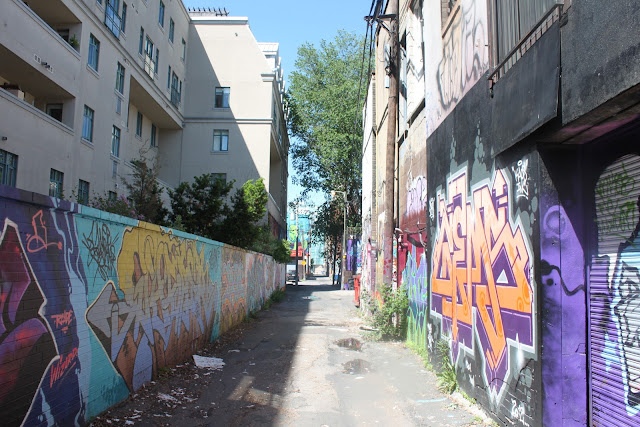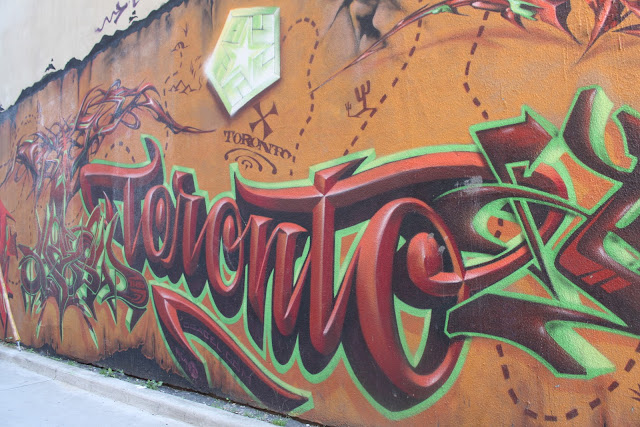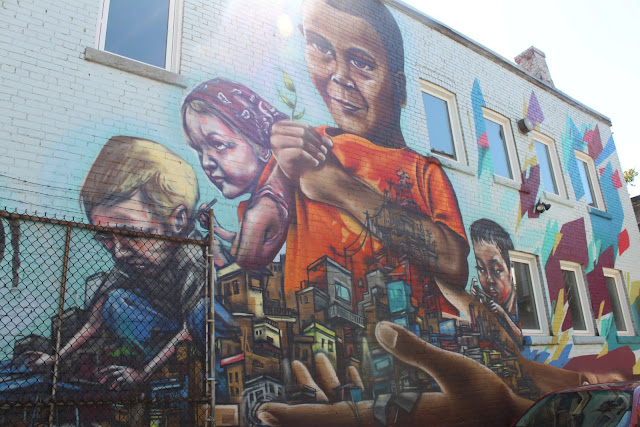Street art has become my favorite thing to discover in a new city. I was in Toronto for the Travel Blog Exchange conference and was staying at Planet Traveler near Kensington Market, a place ideal for spotting street art. And while in the past I’ve simply taken pictures of what I thought looked interesting, this experience was different.
After exploring random alleyways on my own en route to the conference, I took a street art and graffiti tour with Jason, a local tour guide who works for Urban Adventures and his own company, Tour Guys. He spent over a year doing research for the street art tour, learning about the history and methods and meeting the local artists.
What makes Toronto street art different from other work I’ve seen is the fine line between legal and illegal, between artwork and vandalism, between spray paint, stickers and mixed media. The street art culture began in the United States in the 1970s in New York and Philadelphia. Teenagers learned how to manipulate the spray paint caps to change the width of the lines, making it another tool of expression.
Most people started out “tagging,” or writing their name or nickname in a funky style. It could be on a building, a subway car or anywhere else. From there, it snowballed into more full scale “pieces,” which could take up a whole wall. Street art and graffiti came to be associated with gangs, although that’s far from the case now.
As with many other cities in the last 40 years, the local government in Toronto started to campaign against the graffiti. They saw it as a nuisance and as destruction of property rather than creative expression.
However, the times have changed in the favor of these artists, with people like Banksy and Shepherd Fairey becoming household names. There is now a policy of determining what is art and what is vandalism. It mostly comes down to permission, as there are some sanctioned spaces for street art.
But if you don’t have permission you could be arrested. And what’s even more concerning is that the property owners are fined if the graffiti is not removed in a timely manner. There are hotlines to call if you see graffiti.
There is an innate political aspect to street art and graffiti, whichever you prefer. Politicians are often the subject of caricatures created in spray paint. Most recently is Toronto’s mayor, who was busted for using crack, depicted as a worm. Other artists aren’t immune either. If someone feels like one artist is disrespecting another, they are called a “toy” and may have their work defaced.

A rivalry exists between artists, especially the purists who stick to spray paint and those who use stencils. There are unspoken rules about where you can work. It’s considered bad form to paint over someone’s piece, particularly if it’s of a lower quality than what was there before.

Jason named well-known artists from the area who seem to have their own following of fellow artists. Indigo and Elixr created the children’s mural at the top. Uber is known for painting chickens all over town doing things like listening to music or texting. He also creates full scale murals for companies, most recently Facebook’s Toronto office, and the sea life work below. It was coated in wax to prevent others from wrecking it.
If you don’t get a chance to go on the tour, start your journey in Kensington Market and work your way south. From there, head over to Queen Street West, home to the “Hug Tree,” before going to Rush Lane, Toronto’s “graffiti alley,” which begins at Spadina and Bulwer.
The Street Art and Graffiti tours run on Saturdays at 3 pm but check the website for details, as it does change seasonally.
I received a complimentary Street Art and Graffiti tour as a part of the Travel Blog Exchange conference, but all opinions about my awesome tour guide are my own. I also recommend his “Beer Makes History Better” tour.









Whoever creates these art are very talented. Like it dislike it, but lets face it, its unique.
The hug me on the tree is quite interesting, a lot of thought must have gone into it.